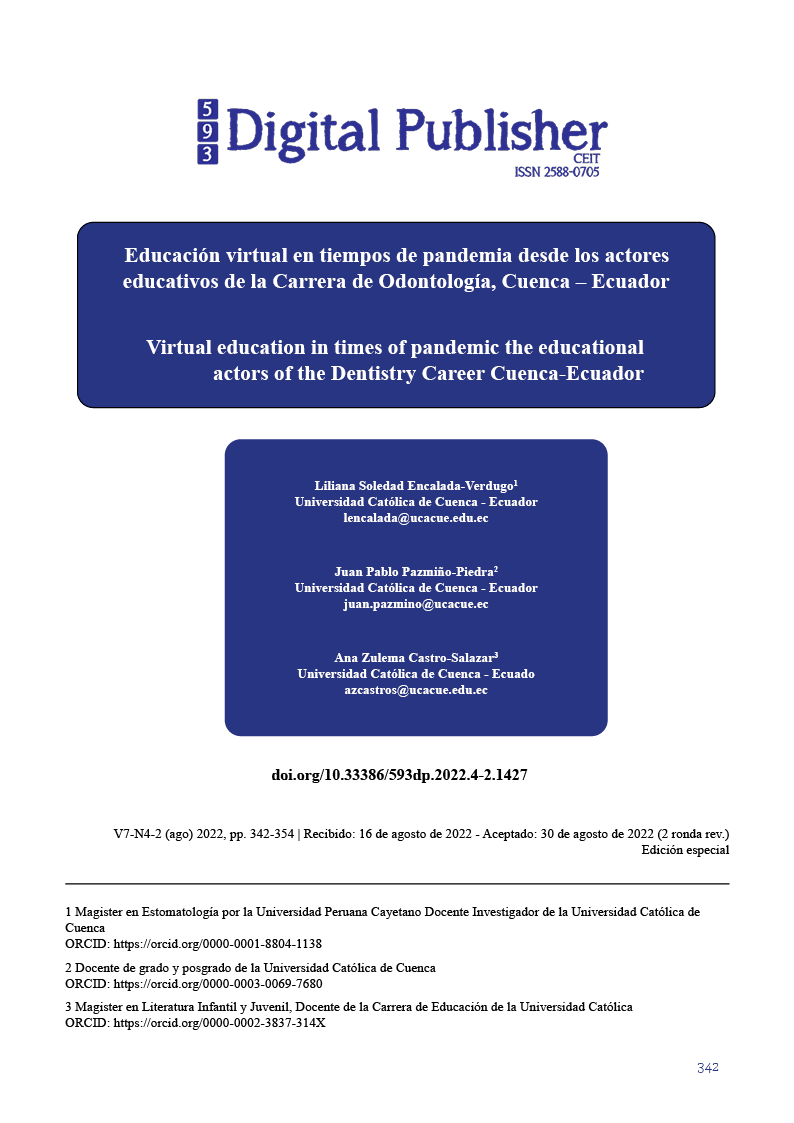Virtual education in times of pandemic the educational actors of the Dentistry Career Cuenca-Ecuador
Main Article Content
Abstract
The pandemic left virtuality as a legacy to the new generations, higher education institutions currently have platforms to teach online classes. This investigation analyzes the organizational, pedagogical and technological capacity of virtual learning teaching of the dentistry career in times of pandemic. The study group was made up of students enrolled in the academic period April September 2020 and teachers who work in the same period. It was a descriptive cross-sectional study, the instruments used obtained a Cronbach's alpha of 0.946 and 0.919 for students and teachers, respectively. The results obtained were quantified on a Likert scale where teachers indicated that the organizational, pedagogical and technological axes in times of pandemic were percentage higher on a very good and excellent scale, while students report a higher percentage for the regular and good scale. It is concluded that despite the fact that students adduce problems of the virtual teaching process in the different axes, it is necessary to emphasize the importance and usefulness of this modality in times of pandemic. Teacher training processes must be maintained and reinforced by the university with respect to digital tools and permanent advice must be provided to educational actors.
Downloads
Article Details

This work is licensed under a Creative Commons Attribution-NonCommercial-ShareAlike 4.0 International License.
1. Derechos de autor
Las obras que se publican en 593 Digital Publisher CEIT están sujetas a los siguientes términos:
1.1. 593 Digital Publisher CEIT, conserva los derechos patrimoniales (copyright) de las obras publicadas, favorece y permite la reutilización de las mismas bajo la licencia Licencia Creative Commons 4.0 de Reconocimiento-NoComercial-CompartirIgual 4.0, por lo cual se pueden copiar, usar, difundir, transmitir y exponer públicamente, siempre que:
1.1.a. Se cite la autoría y fuente original de su publicación (revista, editorial, URL).
1.1.b. No se usen para fines comerciales u onerosos.
1.1.c. Se mencione la existencia y especificaciones de esta licencia de uso.
References
Cadme-Galabay, T. A., García-Herrera, D. G., Cárdenas-Cordero, N. M., & Erazo-Álvarez, J. C. (2020). Comprensión lectora e innovación educativa: estrategias para mejorar la lectoescritura en los jóvenes del bachillerato. Cienciamatria, 6(1), 337-36. https://n9.cl/umys3
Castro-Salinas, D. P., & Ochoa-Encalada, S. C. (2021). Gamificación en el proceso de interaprendizaje: Una experiencia en biología con Genially. Cienciamatria, 7(3), 249-272. https://n9.cl/511xk
Engen, B. K. (2019). Understanding social and cultural aspects of teachers’ digital competencies [Comprendiendo los aspectos culturales y sociales de las competencias digitales docentes]. Comunicar, 61, 9–18.
Inga-Paida, M. I. I., Garcia-Herrera, D. G. G., Castro-Salazar, A. Z. C., & Erazo-Álvarez, J. C. E. (2020). Educación y Covid-19: Percepciones docentes para enfrentar la pandemia. Revista Arbitrada Interdisciplinaria Koinonía, 5(1), 310-331. https://n9.cl/krs31
Jiménez-Segura, F. (2021). Sentido de Vida en el estudiantado universitario por la virtualización de la educación durante la pandemia provocada por la COVID-19: Modelo de Portafolio de resiliencia. Actualidades Investigativas En Educación, 21(3), 1–39. https://doi.org/10.15517/aie.v21i3.48164
Ormaza Andrade, J. E., Ochoa Crespo, J. D., Ramírez Valarezo, F., & Quevedo Vázquez, J. O. (2020). Educación superior e investigación en Latinoamérica: Transición al uso de tecnologías digitales por Covid-19. Revista de Ciencias Sociales, 26(3), 175–193. https://produccioncientificaluz.org/index.php/rcs/index
Panta, G. T. (2021). Percepción del estudiante de la escuela profesional de estomatología de la Universidad Nacional de Piura sobre la educación a distancia en época de pandemia-2021. 1–74. https://repositorio.unp.edu.pe/bitstream/handle/20.500.12676/2857/ESTO-PAN-JUA-2021.pdf?sequence=1&isAllowed=y
Rios-Campos, C., Campos, P. R., Delgado, F. C., Ramírez, I. M., Hubeck, J. A., Fernández, C. J., Vega, Y. C., & Méndez, M. C. (2021). Covid-19 and Universities in Latin America. South Florida Journal of Development, 2(1), 577–585. https://doi.org/10.46932/sfjdv2n1-041
Sáiz-Manzanares, M. C., Casanova, J. R., Lencastre, J. A., Almeida, L., & Martín-Antón, L. J. (2022). Student satisfaction with online teaching in times of COVID-19. Comunicar, 30(70), 31–40. https://doi.org/10.3916/C70-2022-03
Salazar, H., & Alberto, C. (2021). Entornos virtuales como herramienta de apoyo al sistema de aprendizaje contable: Un desarrollo necesario. Revista de Ciencias Sociales, XXVII. https://doi.org/10.31876/rcs.v27i.36489
Tejedor, S., Cervi, L., Tusa, F., & Parola, A. (2020). Educación en tiempos de pandemia: reflexiones de alumnos y profesores sobre la enseñanza virtual universitaria en España, Italia y Ecuador. Revista Latina, 78, 1–21. https://doi.org/10.4185/rlcs-2020-1466
Toledo, B., Castillo, C., Montecinos, V., Briceño, H., & Castillo, S. C. (2020). Modelo de gestión educativa para programas en modalidad virtual de aprendizaje. Revista de Ciencias Sociales, 26(2). https://doi.org/10.31876/rcs.v26i2.32442
UNESCO. (2020). COVID-19 y educación superior : De los efectos inmediatos al día después. Unesco, 5–6. https://n9.cl/zfdhn
Vargas, K. A., & Bravo, D. G. (2020). Kleiderman Antonio Vargas Jiménez. 96. https://n9.cl/5uc1i
William, J., Rosana, A., Díaz-ronceros, E., & Marín-rodriguez, W. J. (2021). Enseñanza virtual en tiempos de pandemia: Estudio en universidades públicas del Perú. Revista de Ciencias Sociales, XXVII(3). https://doi.org/10.31876/rcs.v27i3.36780




